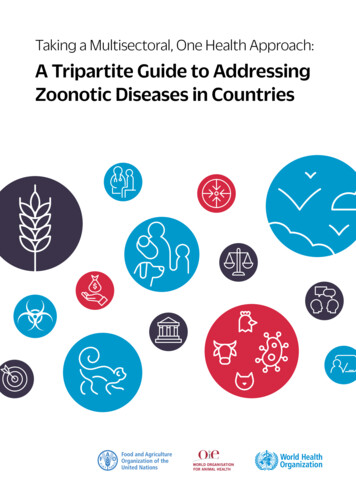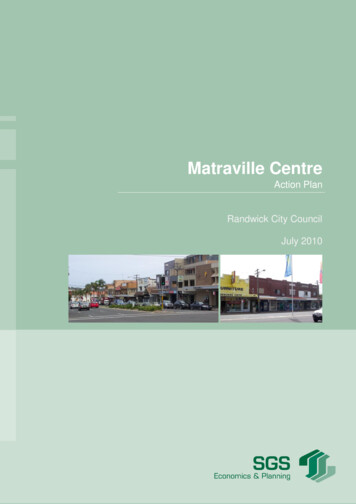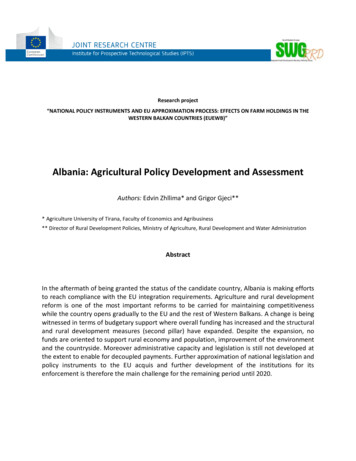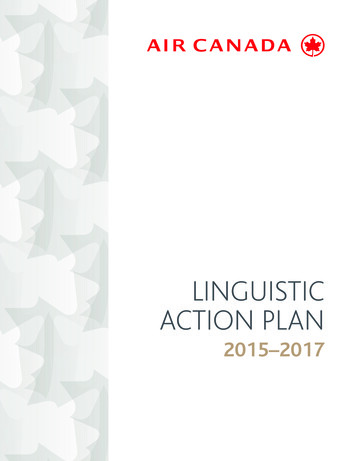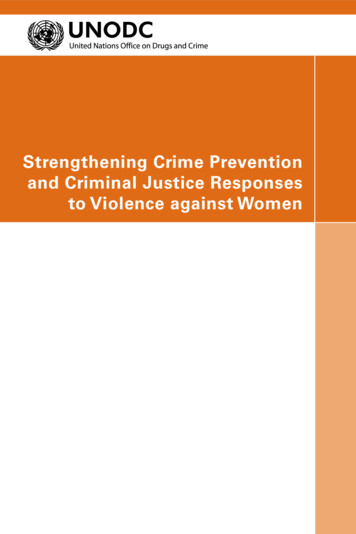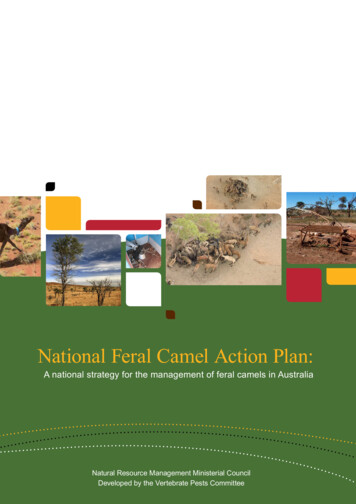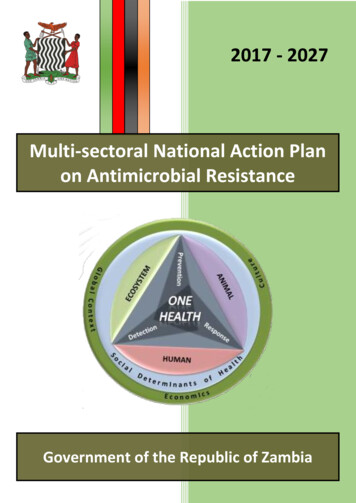
Transcription
2017 - 2027Multi-sectoral National Action Planon Antimicrobial ResistanceGovernment of the Republic of Zambia
Table of ContentsACKNOWLEDGEMENTS . 2ABBREVIATIONS AND ACRONYMS . 3FOREWORD . 5EXECUTIVE SUMMARY . 6BACKGROUND . 11Socio-Economic Status . 15Human Health Services . 17Animal Health Services . 20Veterinary Services System . 20Veterinary Laboratory Infrastructure . 20Medicine Regulation. 22OVERVIEW OF AMR. 23AIMS AND OBJECTIVES OF AMR NAP . 26SITUATIONAL ANALYSES AND ASSESSMENT . 27COUNTRY RESPONSE. 33STAKEHOLDER IDENTIFICATION . 33GOVERNANCE AND LEADERSHIP. 36ORGANOGRAM FOR GOVERNANCE AND COORDINATION . 45STRATEGIC PLAN . 46OPERATIONAL PLAN AND BUDGET . 50MONITORING AND EVALUATION PLAN . 63Monitoring and Evaluation Results Framework . 70REFERENCES . 73LIST OF CONTRIBUTORS . 77ANNEX 1 . 78ACTS OF PARLIAMENT . 78POLICIES . 78INTERNATIONAL AGREEMENTS AND STANDARDS . 782017 – 2027 Multisectoral National Action Plan on Antimicrobial Resistance, Zambia.Page 1 of 79
ACKNOWLEDGEMENTSThis National Antimicrobial Resistance Action Plan was prepared by the National MultiSectorial Technical Working Group on Antimicrobial Resistance, whose membership wasdrawn from the Ministries of Health; Fisheries and Livestock; and, Agriculture. Othermembers were drawn from ZEMA, ICAP, ZCHI, Academia, WHO, and CDC.The Government of the Republic of Zambia is grateful to all of them for their effort andexpertise in collecting data for the situation analysis, and writing the NAP.Special thanks are extended to the CDC, WHO and FAO for material and financial supportduring collaborative workshops and meetings in the development process of thisdocument.Furthermore, the Government would like to appreciate the services of other governmentofficials, particularly Permanent Secretaries in respective Ministries who contributedstaff and supported them to undertake this initiative.2017 – 2027 Multisectoral National Action Plan on Antimicrobial Resistance, Zambia.Page 2 of 79
ABBREVIATIONS AND NALEICAntimicrobial ResistanceAntimicrobial Resistance Coordinating CommitteeAntimicrobial UseAssessment Tool for Laboratory and AMR Surveillance SystemAfrica Union Inter African Bureau for Animal ResourcesCenters for Disease Control and PreventionChurches Health Association of ZambiaCentre for Infectious Disease Research in ZambiaCommon Market for Eastern and Southern AfricaContinuous Professional DevelopmentCentral Statistical OfficeDistrict Development Coordinating CommitteesDepartment for International DevelopmentDepartment of Veterinary ServicesElectronic Logistics Management Inventory SystemElectronic Zambia Inventory Commodities SystemExpanded Programme for ImmunizationExternal Quality AssuranceEuropean UnionFood and Agriculture OrganizationGross Domestic ProduceGross National ProductGlobal Antimicrobial Resistance Surveillance SystemHuman Immunodeficiency VirusHead QuartersIntegrated Disease Surveillance and ResponseInformation, Education and CommunicationInternational Fund for Agricultural DevelopmentInfection Prevention and ControlInternational Plant Protection ConventionJoint Annual ReviewsJohn Snow Inc.Laboratory Information Management SystemLivestock Information Management SystemMalaria Indicator SurveyMinistry of HealthMedium-Term Expenditure FrameworkMid-Term ReviewsNational Livestock Epidemiology and Information Centre2017 – 2027 Multisectoral National Action Plan on Antimicrobial Resistance, Zambia.Page 3 of 79
CWHOZEMAZAMRAZCHIZNPHINational Action PlanNational Development PlanNational Focal PointsNational Health AccountNon-Governmental OrganizationNon-Governmental Organizations Coordinating CouncilNational Multi-sectoral Steering CommitteeNational Public Health InstituteNation Tuberculosis ProgramWorld Organization for Animal HealthProvincial Development Coordinating CommitteeQuality Management SystemSouthern African Development CommunitySouthern African Development Community Parliamentary ForumStandard Operating ProceduresSexually Transmitted InfectionsTuberculosisTraditional and Complimentary MedicinesTerms of ReferenceTechnical Working GroupUnited Nations Development ProgramUnited Nations Children's FundUniversity of ZambiaUnited States Agency for International DevelopmentUniversity Teaching HospitalVeterinary Drug ResiduesWorld Animal Health Information SystemWard Development CommitteesWorld Health OrganizationZambia Environmental Management AgencyZambia Medicines Regulatory AuthorityZambia Community Health InitiativeZambia National Public Health Institute2017 – 2027 Multisectoral National Action Plan on Antimicrobial Resistance, Zambia.Page 4 of 79
FOREWORDThe World Health Organisation defines Antimicrobial Resistance (AMR) as thedevelopment of resistance in a microorganism – bacterium, virus, fungus, or parasite – toan antimicrobial agent to which it was previously sensitive. Resistance is the property orcharacteristic of the microbe and not the person, animal, and plants affected by themicrobe.Antibiotics are one of the most important therapeutic discoveries in human and animalmedical history that revolutionised the way infections are treated. This has contributedin reducing morbidity and mortality caused by microorganisms. Antimicrobial resistanceis therefore of concern, as previously treatable infections like pneumonia and diarrhoeacan become serious health threats.One of the five strategic objectives in the global action plan to combat AMR is creatingawareness on AMR. Human use and abuse of antimicrobial has accelerated developmentof resistance in some microbes. Evidence based information is therefore required tofacilitate behavioural changes on appropriate use of antimicrobials and safeguard humanand animal health.There is evidence of antimicrobial resistant microorganisms in human and animal healthin Zambia and therefore to tackle this challenge the Zambian Government undertook amulti-sectoral approach to develop this National Action Plan (NAP) in line with the globalAMR strategy.It is our sincere hope that through this NAP, strategic interventions will be initiatedtowards the long-term goal of containing the AMR threat in Zambia, the African region,and the World at large.Permanent Secretary Health Services,Ministry of Health,CHAIRPERSON, AMR NMSCMinistry of Fisheries and LivestockCO-CHAIRPERSON, AMR NMSC2017 – 2027 Multisectoral National Action Plan on Antimicrobial Resistance, Zambia.Page 5 of 79
EXECUTIVE SUMMARYZambia has recognised the Public Health threat of antimicrobial resistance and its impacton morbidity and mortality, as well as the subsequent economic consequences. Thecountry has recorded microorganisms which have developed resistance to antimicrobialdrugs. Notable among these are; Multidrug Resistant Mycobacterium Tuberculosis (MDR),Human Immunodeficiency virus resistant to antiretroviral drugs, Plasmodium resistanceto antimalarial drugs, and fungal species showing indications of resistance to antifungaldrugs. Emergence of “Superbugs” such as Methicillin Resistant Staphylococcus aureus(MRSA), Extended Spectrum beta-lactam (ESBL) producing Klebsiella pneumoniae andVancomycin Resistant Enterococci (VRE) have also been reported. This informationsuggests increasing trends in antimicrobial resistance and suggests that Zambia sharesthe worldwide trend of this problem. This implies that serious conditions of public healthconcern such as diarrhoea, pneumonia, and meningitis may be difficult to treat or notpossible to treat at all.Antimicrobial resistance (AMR) has the potential of becoming a global pandemic in thenear future. In response to this possible threat, the World Health Organization (WHO),the Food and Agriculture Organization (FAO), and the World Animal Health Organization(OIE) signed a tripartite agreement whose objective is to foster concerted efforts aimedat combating the threat of AMR at a global level.Member states signed an agreement to adopt the resolutions contained in the tripartiteagreement, and at the 2015 World Health Assembly (WHA) of the WHO, it was agreedthat National Action Plans (NAPs) on AMR be developed by May, 2017. Consequently,Zambia through the President, His Excellency Mr. Edgar Chagwa Lungu at the 71st UNGeneral Assembly of September 2016, where a declaration for a collaborative globalresponse to the threat of AMR was made, asserted to join the fight against AMR.Zambia has developed a Multisectoral National Action Plan (NAP) to address ways ofcombating antimicrobial resistance. The country has adopted the “One Health” approachas proposed in the Global Action plan (GAP) on antimicrobial resistance. Hence this planwas developed by a multidisciplinary team that was constituted from different sectors inMay 2016. The Ministry of Health as the lead Ministry drew members of the committeefrom different sectors. These were personnel from the following sectors; human health,2017 – 2027 Multisectoral National Action Plan on Antimicrobial Resistance, Zambia.Page 6 of 79
agriculture, livestock, environmental protection, academia, regulatory bodies, civilsociety, planning and finance. This plan is therefore representative of a broad-basedconsensus on actions to be undertaken to combat the threat of antimicrobial resistance.The country has a National Multi-Sectoral Steering Committee (NMSC) which shall guide,oversee, and monitor AMR-related activities in all sectors to ensure a systematic andcomprehensive implementation. This is composed of Permanent Secretaries from keyMinistries and cooperating partners, WHO, FAO, OIE, CDC and other key partners. TheAnti-Microbial Resistance Coordinating Committee (AMRCC) shall co-ordinate andimplement AMR related activities, while focal point persons from different sectors shallcoordinate AMR activities and tasks in their respective sectors. The focal point personswill lead different technical working groups (TWG) in five key areas.The NAP on antimicrobial resistance has adopted the five strategic objectives from theGlobal Action Plan (GAP) which was adopted at the World Health Assembly in May 2015.The five-strategic objective are;1.To improve awareness and understanding of antimicrobial resistance througheffective communication, education and training;2.To strengthen the knowledge and evidence base through surveillance andresearch;3.To reduce the incidence of infection through effective sanitation, hygiene andinfection prevention measures;4.To optimize the use of antimicrobial medicines in human and animal health;5.To develop the economic case for sustainable investment that takes account of theneeds of all countries and to increase investment in new medicines, diagnostictools, vaccines and other interventions.The main objective of the Multi-Sectoral Antimicrobial Resistance National Action Plan isto provide a coherent framework for combating AMR using the “One Health” approachembracing human, animal, agriculture and environment sectors in Zambia from 2017 to2027.2017 – 2027 Multisectoral National Action Plan on Antimicrobial Resistance, Zambia.Page 7 of 79
The AMR-NAP outlines the status quo and acknowledges challenges of antimicrobialresistance (AMR) in Zambia among its population estimated at about 16,500,000 peoplein 2016. Excessive or inappropriate use, among other problems that can lead to theemergence of antimicrobial resistance, have been documented.Furthermore, the plan outlines the Country response in which various stakeholders havebeen identified. In addition to this, it provides for a governance and leadership structure;strategic plan; operational plan and budget estimated at US 17,893,100 and, monitoringand evaluation plan.The focus areas that have been addressed in this plan include; awareness and education,surveillance and research, regulation, infection prevention, sanitation and hygiene,optimising drug use and investment in research and development. A summary of each ofthese priority areas and actions to be undertaken are as follows;Awareness and educationThe plan proposes to establish an evidence-based public communications programmetargeting audiences in human, animal, plant and environment practices. This shall bedone by estimating awareness and knowledge through behavioural studies in differentprofessional groups then design communications programmes. The plan promotes theinclusion of AMR and related topics into the education curricula at all levels, and developaccredited continuing professional development (CPD) and in-service trainingprogrammes on AMR, including alternative learning methods.Surveillance and researchA national coordination structure for surveillance of AMR shall be establishedinterlinking the sector-specific surveillance systems into the National SurveillanceSystem. A traceability strategy for food safety surveillance system shall include AMR.Laboratory capacity (human, material and infrastructure) will be built and an AMRlaboratory network shall be established and linked to the Global AntimicrobialSurveillance system, a platform for sharing AMR data. This is important to ensure reliabledrug susceptibility data and will provide information to interpret trends and variationsin rates of AMR for policy decisions. Surveillance in agriculture will allow for earlydetection of pathogens that enter the food chain, and their resistance patterns andprovide information to develop intervention strategies.2017 – 2027 Multisectoral National Action Plan on Antimicrobial Resistance, Zambia.Page 8 of 79
An AMR research plan shall be developed and implemented through engagement ofresearch institutions and researchers who shall mobilize resources for conductingresearch in accordance with the national AMR research plan.RegulationLegal provisions in the existing regulations shall be strengthened to address AMR andrelated factors. Regulations for antimicrobials in food and feed shall be enforced, as wellas strengthen antimicrobial policies and standard treatment guidelines for human,terrestrial and aquatic animals, plants, and environment.Infection prevention, sanitation and hygieneNational coordination structures for sanitation, infection prevention and control,hygiene, biosecurity, and phytosanitary shall be established. Situation analysis onsanitation, infection prevention and control, hygiene, biosecurity, and phytosanitary shallbe conducted, and national guidelines and protocols will be developed or revised. Thereshall be advocacy to the players at all levels to implement the national guidelines.Promotion of vaccination programmes will also be enhanced. Interventions in this keyarea will prevent and control emergence of the existing AMR problems in Humanagriculture and veterinary sectors.Optimal use of antimicrobial medicines in human, animal, and plant healthThere’s a plan to establish/strengthen antimicrobial stewardship programmes in human,animal, and plant health practice through engagement of healthcare facility managementand professional bodies to mainstream stewardship committees. The plan also proposesto strengthen the pharmaceutical manufacturing and supply chain by reviewing andstrengthening the existing quality management system for the supply of medicines,covering manufacturing, production, storage, transport etc. and strengthening theregulatory mechanisms (ZAMRA and Professional bodies) for access to antimicrobialmedicines in human, animal, and plant health. Quality management systems will beintroduced at all levels of the supply chain. Guidelines for proper disposal ofantimicrobials, and animal, and plant waste will also be developed.2017 – 2027 Multisectoral National Action Plan on Antimicrobial Resistance, Zambia.Page 9 of 79
Investment for research and development of new medicines, vaccines, diagnostictools, and other interventions.A plan to secure and use financing for implementation of the AMR NAP and measure theburden of AMR in various sectors. This shall include assessment and mobilisation ofinvestment requirements for implementation and development of policies, guidelines,and procedures for implementation of NAP. Measurements of QALYs, DALYs, mortalityrates, cost associated to infectious diseases/bed spaces/drugs/treatment shall be doneto establish the impact of AMR with periodic efficacy studies on antimicrobial medicines.The plan promotes access to incentives for industry to invest in the research anddevelopment of new antimicrobials and vaccines, and promotes linkages among variousrelevant stakeholders to search for new drugs, vaccines and diagnostic tools.The implementation of this plan will require close collaboration among all stakeholders,and it is hoped that there shall be timely dissemination of data to relevant parties in orderto take quick actions to contain the spread of antimicrobial resistant pathogens.2017 – 2027 Multisectoral National Action Plan on Antimicrobial Resistance, Zambia.Page 10 of 79
BACKGROUND1.0Country ProfileAdministrative, Demographic and Community structuresZambia is a landlocked Sub-Saharan country sharing boundaries with Malawi,Mozambique, Zimbabwe, Botswana, Namibia, Angola, Democratic Republic of the Congoand Tanzania. It has a total surface area of about 752,614 Km2, and is among the biggestcountries in Southern-Central Africa.Zambia’s annual average temperature is 20⁰C and the relative humidity averages around61.5% per annum (range 34% - 86%). The coldest period is between June and July andthe warmest is October.Administratively, the country is divided into ten provinces, namely: Central, Copperbelt,Eastern, Luapula, Muchinga, Lusaka, North-Western, Northern, Southern, and Westernprovinces. Each of these provinces is subdivided into districts and there are currently 109districts in the country (figure 1). A district is divided into constituencies that are madeup of wards. Lusaka is the capital city and administrative headquarters for government.There are three wings of governance; executive, legislative and traditional leadership ineach district. For any program to receive adequate support, all the three wings need tobe involved so that all aspects are well handled.Under the executive leadership is the District Commissioner who is appointed andoversees that government policies and programs are implemented. The Members ofParliament are under the legislative wing and are in-charge of constituencies in thedistrict. They facilitate and initiate community based developmental projects. Thetraditional leadership works with the communities and assists in the implementation ofthe government programs. For operational purposes, there are various structures whichinclude zones, Ward Development Committees (WDC), District DevelopmentCoordinating Committees (DDCC), and at provincial level, the Provincial DevelopmentCoordinating Committee (PDCC).2017 – 2027 Multisectoral National Action Plan on Antimicrobial Resistance, Zambia.Page 11 of 79
Figure1: Map showing provinces and districts in Zambia (Courtesy of the Department of Veterinary Services)The population of Zambia has been increasing from 7,759,161 in 1990 to 13,046,508persons in 2010 (figure 2), giving an average annual growth rate of 2.8 % between 2000and 2010 (CSO, 2010). The 2016 estimated population stands at 17,117,369 (Countrymeters, 2017). The most populated province is Lusaka with a density of 100.4 personsper square kilometre whereas North-western province has the least with 5.6 persons persquare kilometre. There are seventy-three (73) local languages, while Bemba, Kaonde,Lozi, Lunda, Luvale, Nyanja, and Tonga are the main local languages spoken. English isZambia’s official language.2017 – 2027 Multisectoral National Action Plan on Antimicrobial Resistance, Zambia.Page 12 of 79
Figure 2: Population Distribution by Province in, Zambia, 2010 census (Courtesy of the Department ofVeterinary Services)The Male: Female ratio is 0.99: 1.01 and the age structure is 17.2% for 0-5years, 29.5%5-14 years, 43.2% for 15-50 years and 10.1% for those above 50 years. The currentpopulation structure shows a predominatly younger population with a median age of 17years (figure 3). The average life expectancy is 57 years (males 57 and females 58). Theinfant mortality rate is 45deaths /1000 live births, while the percentage of of childrenunder 5 years who were under weight was 15% (CSO, 2015).2017 – 2027 Multisectoral National Action Plan on Antimicrobial Resistance, Zambia.Page 13 of 79
Figure 3: Zambia Population structures (Courtesy of CSO, 2010 Census of Population and Housing Report)The Department of Veterinary Services (DVS) estimated the population of cattle to havebeen 2.2 million in 1990 (DVS annual report 1990) and 4.2 million in 2016 (DVS annualreport 2016). Approximately 20% of this national herd is in the commercial sector with80% in traditional sector. The commercial sector utilises more modern productionmethods with a relatively higher input (including veterinary products) and outputs thanthe traditional sector (Aregheore, 2009). It is estimated that cattle number in thetraditional sector increases by 3.5% per annum (Daka, 2002). Population figures arebased on administrative data collection in the districts and growth projections withcorrections as the livestock census has not been undertaken in over 20 years. Thedetailed cattle and other livestock population by province for the year 2016 is shown inTable 1.2017 – 2027 Multisectoral National Action Plan on Antimicrobial Resistance, Zambia.Page 14 of 79
Table 1: Livestock population by province, perbeltSouthernWesternTotal(Source: National Livestock Epidemiology and Information Centre – NALEIC)Socio-Economic Status and IndicatorsSocio-Economic StatusZambia is one of Sub-Saharan Africa's highly urbanized countries. Around half of thecountry's population is concentrated in a few urban zones strung along the majortransportation corridors, while rural areas are scantly populated. Most of theemployment opportunities lie along the major transportation corridors, butunemployment and onal GDP has doubled since independence in 1964. However, due to high birth ratesand AIDS amongst other factors, per capita annual incomes are currently at about twothirds of their levels at independence. As of 2015 the gross domestic product (GDP) percapita stands at 1,330 (World Bank, 2015). Zambia is one of the fastest growingeconomies in Africa and its capital, Lusaka is the fastest growing city in theSouthernAfrican Development Community (SADC)(https://en.wikipedia.org/wiki/Economy of Zambia#cite note-SADC ).The Seventh National Development Plan 2017-2021 (SNDP) provides practicalimplementation strategies for the government’s goals to achieve economictransformation through an integrated approach that links key sectors. For example, by2017 – 2027 Multisectoral National Action Plan on Antimicrobial Resistance, Zambia.Page 15 of 79
leveraging the joint potential of agriculture and tourism, the government intends togalvanize and stimulate diversification. The NDP provides an opportunity to prioritizegovernment objectives toward poverty reduction and strengthening the linkagesbetween budgeting and planning. It is part of the cascading system of planning thatcommenced with the Vision 2030 prepared in 2005, based on the African Union’s Agenda2063. The national development agenda is spearheaded by the Ministry of NationalPlanning and Development, while the NDP and Vision 2030 are executed through MTEFand annual budgetsContribution of the Crop and Livestock Sector to the EconomyThe fisheries and livestock sectors have been identified to be among the key drivers inreducing poverty, especially in rural communities, with the potential to contribute tosustained economic growth. The Zambian Government has therefore created a Ministrydedicated to Fisheries and Livestock to adequately address the affairs of the two sectors.The Agricultural sector contributes about 21% of GDP, of which the Livestock sector’scontribution is approximately 42% (IFAD, 2014; IAPRA, 2012). The agricultural sectorsupports the livelihood of over 70% of the population, employing 78% of women and69% of men.In Zambia, about 23% of the per capita supply of protein comes from animal products(Aregheore, 2009). The major sources of animal protein are beef, pork, chicken, fish, milk,egg, and to a lesser extent, sheep, goat, and rabbit meat. There are other traditionalsources of animal protein such as game meat, rats, monitor lizards, insects, frogs, and wildbirds. Cattle contribute at least 61% of the meat and milk consumed in the country. Thelivestock sector has tremendous potential and capacity in contributing to povertyalleviation, increasing the socio-economic status of most people and, consequently,contributing significantly to the economic growth of the country. However, the potentialof the sector is under-estimated. The sector has experienced low production andproductivity resulting from a range of factors including, high disease prevalence, poorhusbandry management especially among the small-scale farmers and inadequatediversification and integration of small livestock.2017 – 2027 Multisectoral National Action Plan on Antimicrobial Resistance, Zambia.Page 16 of 79
Farming systems vary according to agro-ecological conditions, but are dominated byMaize. Small holder farmers also cultivate Sorghum, rice, millet, beans, groundnuts, sugarcane, vegetables and cassava. Commercial crop farming focuses on cash crop productionincluding wheat, soybeans, tea, coffee, tobacco, cotton, and floriculture. Antimicrobials,mainly anti-fungals, and chemicals are used to support production, and if not guarded,have the potential to affect AMR.Transportation and CommunicationZambia’s transport system comprises of airports, road network, railway and watertransport. Zambia’s four designated international airports are found in Lusaka,Livingstone, Mfuwe and Ndola, with Kenneth Kaunda International Airport (KKIA) inLusaka being Zambia’s main airport. Other airfields and airstrips are found in variouslocations including Chipata, Kitwe, Kasama, Mongu, Solwezi and Mansa.The telecommunication system in Zambia is generally good. Internet connectivity andmobile phon
2017 - 2027 Multisectoral National Action Plan on Antimicrobial Resistance, Zambia.Page 2 of 79 ACKNOWLEDGEMENTS This National Antimicrobial Resistance Action Plan was prepared by the National Multi-Sectorial Technical Working Group on Antimicrobial Resistance, whose membership was
